Book contents
- Frontmatter
- Contents
- List of contributors
- Foreword
- Preface
- 1 Introduction
- 2 The Factor Separation Methodology and the fractional approach
- 3 Investigation of the Factor Separation features for basic mathematical functions
- 4 Factor Separation Methodology and paleoclimates
- 5 Meso-meteorology: Factor Separation examples in atmospheric meso-scale motions
- 6 Using the Alpert–Stein Factor Separation Methodology for land-use land-cover change impacts on weather and climate process with the Regional Atmospheric Modeling System
- 7 Application of Factor Separation to heavy rainfall and cyclogenesis: Mediterranean examples
- 8 Experience in applying the Alpert–Stein Factor Separation Methodology to assessing urban land-use and aerosol impacts on precipitation
- 9 Free and forced thermocline oscillations in Lake Tanganyika
- 10 Application of the Factor Separation Methodology to quantify the effect of waste heat, vapor and pollution on cumulus convection
- 11 The use of the Alpert–Stein Factor Separation Methodology for climate variable interaction studies in hydrological land surface models and crop yield models
- 12 Linear model for the sea breeze
- 13 Experience and conclusions from the Alpert–Stein Factor Separation Methodology
- 14 Tagging systematic errors arising from different components of dynamics and physics in forecast models
- 15 Some difficulties and prospects
- 16 Summary
- Appendix: References employing the Alpert–Stein Factor Separation Methodology
- References
- Index
14 - Tagging systematic errors arising from different components of dynamics and physics in forecast models
Published online by Cambridge University Press: 03 May 2011
- Frontmatter
- Contents
- List of contributors
- Foreword
- Preface
- 1 Introduction
- 2 The Factor Separation Methodology and the fractional approach
- 3 Investigation of the Factor Separation features for basic mathematical functions
- 4 Factor Separation Methodology and paleoclimates
- 5 Meso-meteorology: Factor Separation examples in atmospheric meso-scale motions
- 6 Using the Alpert–Stein Factor Separation Methodology for land-use land-cover change impacts on weather and climate process with the Regional Atmospheric Modeling System
- 7 Application of Factor Separation to heavy rainfall and cyclogenesis: Mediterranean examples
- 8 Experience in applying the Alpert–Stein Factor Separation Methodology to assessing urban land-use and aerosol impacts on precipitation
- 9 Free and forced thermocline oscillations in Lake Tanganyika
- 10 Application of the Factor Separation Methodology to quantify the effect of waste heat, vapor and pollution on cumulus convection
- 11 The use of the Alpert–Stein Factor Separation Methodology for climate variable interaction studies in hydrological land surface models and crop yield models
- 12 Linear model for the sea breeze
- 13 Experience and conclusions from the Alpert–Stein Factor Separation Methodology
- 14 Tagging systematic errors arising from different components of dynamics and physics in forecast models
- 15 Some difficulties and prospects
- 16 Summary
- Appendix: References employing the Alpert–Stein Factor Separation Methodology
- References
- Index
Summary
This study summarizes the results from a large number of forecast experiments with a global model with the objective of tagging errors that arise from different components of model dynamics and physics. To sort out such errors in non-linear systems is generally very difficult. In this study, we show examples of model forecasts that illustrate deficiencies (i.e., errors) that arise in the parameterization of cumulus convection and in the planetary boundary layer (PBL) physics. Our proposed Factor Separation method enables us to tag the systematic errors in our PBL formulation of moisture convergence. We note that the PBL scheme overestimates by roughly a factor of 2 the convergence near the tropical cloud base. These errors were the largest over meso-convective regions of deep convection. With such efforts at error tagging further improvements in modeling and forecasts can be achieved. We also address further work in this area of research.
Introduction
Factor Separation (FS), introduced by Stein and Alpert (1993) and Alpert et al. (2006), permits an explicit separation of atmospheric synergies among several salient features of a forecast model. They have exploited the FS method covering many scales of modeling to answer questions on issues such as the role of water and carbon dioxide for the understanding of global change. Their proposed method has many wide-ranging applications, as seen from the contents of this book. Our proposed study follows the same rationale in asking how one can sort out and tag errors that arise from different components of a non-linear model during the evolution of weather or climate.
- Type
- Chapter
- Information
- Factor Separation in the AtmosphereApplications and Future Prospects, pp. 219 - 236Publisher: Cambridge University PressPrint publication year: 2011



